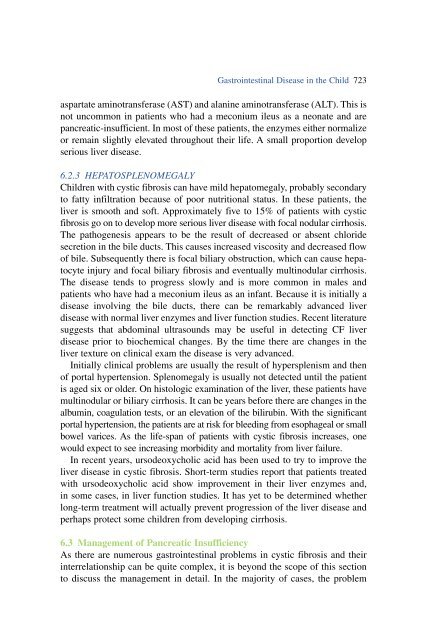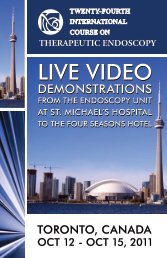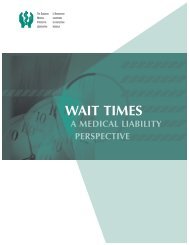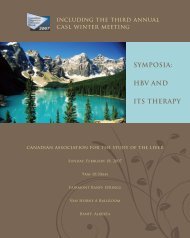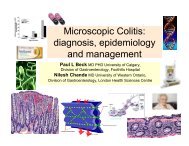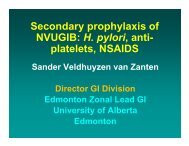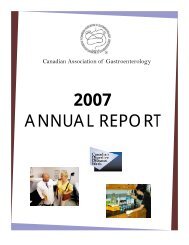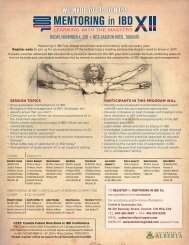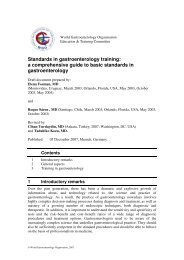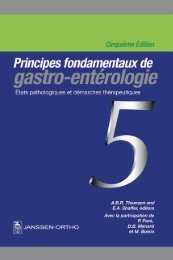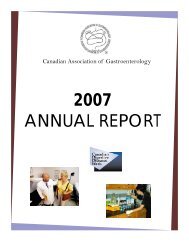Manifestations of Gastrointestinal Disease in the Child
Manifestations of Gastrointestinal Disease in the Child
Manifestations of Gastrointestinal Disease in the Child
You also want an ePaper? Increase the reach of your titles
YUMPU automatically turns print PDFs into web optimized ePapers that Google loves.
<strong>Gastro<strong>in</strong>test<strong>in</strong>al</strong> <strong>Disease</strong> <strong>in</strong> <strong>the</strong> <strong>Child</strong> 723<br />
aspartate am<strong>in</strong>otransferase (AST) and alan<strong>in</strong>e am<strong>in</strong>otransferase (ALT). This is<br />
not uncommon <strong>in</strong> patients who had a meconium ileus as a neonate and are<br />
pancreatic-<strong>in</strong>sufficient. In most <strong>of</strong> <strong>the</strong>se patients, <strong>the</strong> enzymes ei<strong>the</strong>r normalize<br />
or rema<strong>in</strong> slightly elevated throughout <strong>the</strong>ir life. A small proportion develop<br />
serious liver disease.<br />
6.2.3 HEPATOSPLENOMEGALY<br />
<strong>Child</strong>ren with cystic fibrosis can have mild hepatomegaly, probably secondary<br />
to fatty <strong>in</strong>filtration because <strong>of</strong> poor nutritional status. In <strong>the</strong>se patients, <strong>the</strong><br />
liver is smooth and s<strong>of</strong>t. Approximately five to 15% <strong>of</strong> patients with cystic<br />
fibrosis go on to develop more serious liver disease with focal nodular cirrhosis.<br />
The pathogenesis appears to be <strong>the</strong> result <strong>of</strong> decreased or absent chloride<br />
secretion <strong>in</strong> <strong>the</strong> bile ducts. This causes <strong>in</strong>creased viscosity and decreased flow<br />
<strong>of</strong> bile. Subsequently <strong>the</strong>re is focal biliary obstruction, which can cause hepatocyte<br />
<strong>in</strong>jury and focal biliary fibrosis and eventually mult<strong>in</strong>odular cirrhosis.<br />
The disease tends to progress slowly and is more common <strong>in</strong> males and<br />
patients who have had a meconium ileus as an <strong>in</strong>fant. Because it is <strong>in</strong>itially a<br />
disease <strong>in</strong>volv<strong>in</strong>g <strong>the</strong> bile ducts, <strong>the</strong>re can be remarkably advanced liver<br />
disease with normal liver enzymes and liver function studies. Recent literature<br />
suggests that abdom<strong>in</strong>al ultrasounds may be useful <strong>in</strong> detect<strong>in</strong>g CF liver<br />
disease prior to biochemical changes. By <strong>the</strong> time <strong>the</strong>re are changes <strong>in</strong> <strong>the</strong><br />
liver texture on cl<strong>in</strong>ical exam <strong>the</strong> disease is very advanced.<br />
Initially cl<strong>in</strong>ical problems are usually <strong>the</strong> result <strong>of</strong> hypersplenism and <strong>the</strong>n<br />
<strong>of</strong> portal hypertension. Splenomegaly is usually not detected until <strong>the</strong> patient<br />
is aged six or older. On histologic exam<strong>in</strong>ation <strong>of</strong> <strong>the</strong> liver, <strong>the</strong>se patients have<br />
mult<strong>in</strong>odular or biliary cirrhosis. It can be years before <strong>the</strong>re are changes <strong>in</strong> <strong>the</strong><br />
album<strong>in</strong>, coagulation tests, or an elevation <strong>of</strong> <strong>the</strong> bilirub<strong>in</strong>. With <strong>the</strong> significant<br />
portal hypertension, <strong>the</strong> patients are at risk for bleed<strong>in</strong>g from esophageal or small<br />
bowel varices. As <strong>the</strong> life-span <strong>of</strong> patients with cystic fibrosis <strong>in</strong>creases, one<br />
would expect to see <strong>in</strong>creas<strong>in</strong>g morbidity and mortality from liver failure.<br />
In recent years, ursodeoxycholic acid has been used to try to improve <strong>the</strong><br />
liver disease <strong>in</strong> cystic fibrosis. Short-term studies report that patients treated<br />
with ursodeoxycholic acid show improvement <strong>in</strong> <strong>the</strong>ir liver enzymes and,<br />
<strong>in</strong> some cases, <strong>in</strong> liver function studies. It has yet to be determ<strong>in</strong>ed whe<strong>the</strong>r<br />
long-term treatment will actually prevent progression <strong>of</strong> <strong>the</strong> liver disease and<br />
perhaps protect some children from develop<strong>in</strong>g cirrhosis.<br />
6.3 Management <strong>of</strong> Pancreatic Insufficiency<br />
As <strong>the</strong>re are numerous gastro<strong>in</strong>test<strong>in</strong>al problems <strong>in</strong> cystic fibrosis and <strong>the</strong>ir<br />
<strong>in</strong>terrelationship can be quite complex, it is beyond <strong>the</strong> scope <strong>of</strong> this section<br />
to discuss <strong>the</strong> management <strong>in</strong> detail. In <strong>the</strong> majority <strong>of</strong> cases, <strong>the</strong> problem


